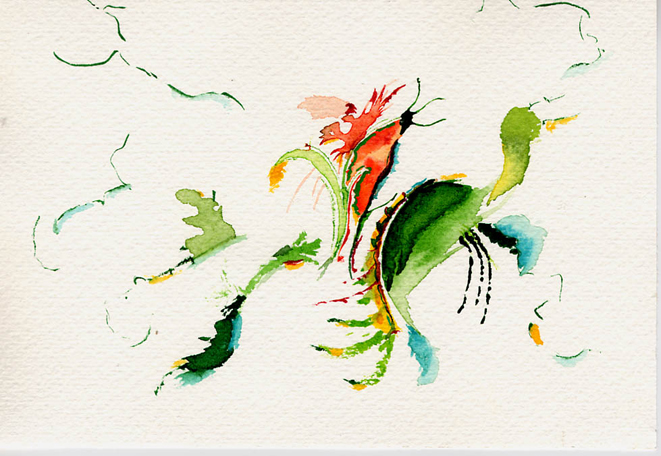Kirsten Kötter: Indische Aquarelle, 2003, Aquarell, 12 × 17 cm (Ausschnitt, Detail)
HOW DO YOU LIKE MY INDIA? (2003)
Auf einer Reise durch Indien (Dehli, Dehra Dun, Rishikesh, Chandigarh, Haridwar, Allahabad, Varanasi), bei der wir u.a. eine deutsche Freundin besuchen, die mit einem Inder verheiratet ist, entstehen Aquarelle, Fotos und ein Video, dass auch mich bei der Produktion der Aquarelle und Fotos zeigt. 'How do you like my india?' hat uns ein Inder auf der Reise gefragt.
Site-specific painting
 Scroll down
Scroll down
'Site-specific painting' ist eine besondere Interpretation der traditionellen Pleinair-Malerei. Ich male an ausgesuchten Orten auf eine besondere Weise: Weder male ich ab, was ich sehe, noch male ich meine 'inneren' Bilder oder Gefühle. Ich male vergleichbar mit dem Automatischen Zeichnen oder Schreiben der Surrealisten. Ich denke nicht nach. Ich habe keinen Plan. Es kann vorkommen, dass ich beim Malen nicht weiß, warum ich eine bestimmte Farbe nehme oder eine Form zeichne. Die fertigen Bilder haben dennoch eine große Ähnlichkeit mit der Umgebung. Ich arbeite auf diese Weise seit 1991
'Site-specific painting' ist eine abstrahierte Umsetzung oder Transformation eines bestimmten Momentes an einem bestimmten Ort. Die Malerei interpretiert die visuellen Momente, aber auch andere Wahrnehmungen, wie Wind, Wetter, Bewegung, Kälte, Hitze, Lärm oder Ruhe. Farben, Formen, Geografie, Licht, Wetter und Jahreszeit bestimmen ihre Bildsprache ebenso wie landestypisches Design, Volkskunst oder Architektur. Die Abstraktionen sind auf wesentliche Teile reduziert. Sie verdichten eine Zeitspanne an einem Ort zu einem Bild. Sie interpretieren ein Ding, einen Ort als lebendiges Etwas. Sie sprechen von der Realität jenseits der sichtbaren Form. Dabei sind sie keine Visionen oder Träume, sondern fest in Ort und Zeit verankert. Der Künstler ist eine Transformations-Maschine.
Die Orte, an denen die Malerei entsteht, sind von großer Bedeutung: Manche Orte und Unorte befinden sich im städtischen Raum. Das Malen ist öffentlich. Leute, die am selben Ort sind, interagieren dann häufig mit mir. Oft liegen die Orte in der Natur und müssen erwandert werden. 'Site-specific painting' hat Bezüge zur Land-Art.
Paul Cézanne malte Pleinair. Er versuchte, nicht nur ein Ding, sondern auch das Wesen des Dinges zu malen. Er nannte das: Malen 'parallel zur Natur'. Besonders seine späten Aquarelle stehen zwischen gegenständlichem Abbild und Abstraktion. Sie stehen zwischen Objektivität und Interpretation. Die Farbe spielt bei Cézanne Werk eine große Rolle. Cézanne malte besonders häufig die Montagne Sainte-Victoire bei Aix-en-Provence. Der Schriftsteller Peter Handke nahm die Bilder Cézannes zum Anlass, seine Literatur auf vergleichbare Weise zu konzeptionieren ('Die Lehre der Sainte-Victoire', 1980). Cézannes Aquarelle waren mir unbekannt, als ich 1991 selbst begann, Aquarelle auf diese Weise zu malen.
'Site-specific painting' is my particular interpretation of traditional outdoor painting, known as 'en plein air' or 'sur le motif'. What sets 'Site-specific painting' apart is the fact that it is done at a special place, and in a special way. I do not exactly paint what I see, nor do I paint my feelings or mental images. My way of working is rather similar to the automatic drawing and writing of the Surrealists. I do not think. I have no plan, no concept. Often I am using a certain color or creating a certain shape without knowing why. Still, the final images has a great similarity with the environment it was created in. I do this since 1991.
One could say that 'Site-specific painting' is an abstract transformation of a particular moment in a particular place. The picture interprets the visual moments and other perceptions, such as wind, cold, heath, noise or silence. Colors, shapes, geography, light, weather and season determine the visual language. Typical local style, folk art or architecture play their part as well. These abstractions are reduced to essential elements. The pictures compress a period of time in a location into an image. They regard a thing, or a place, as a living something. They speak of reality beyond the visual form. They are not visions, nor dreams, but firmly rooted in time and place. The artist is a transformation enginde.
The places where the pictures are created, are of great importance: some places, or non-places, are located in urban areas. Painting in this way is a public act. When I am at work in this way I am frequently addressed by people. Often I use places situated in nature, which are difficult to reach. Site-specific painting has its connections with Land Art.
Paul Cézanne painted 'plein air'. He tried to paint not only a thing, but also the essence of the thing. He called working like this 'parallel to nature'. Especially the late watercolors stand between representation and abstraction. They stand between objectivity and interpretation. Color plays a major role in Cézanne work. He painted very often the Montagne Sainte-Victoire near Aix-en-Provence. The writer Peter Handke took Cézanne's paintings as an example and conceptualized his works in a similar way ('The doctrine of the Sainte-Victoire', 1980). Cézanne's watercolors were unknown to me, even 1991, when I began to work with watercolors.
(Englische Übersetzung / translation in english: Vince van Geffen, Berlin / Barcelona)


 Scroll down
Scroll down